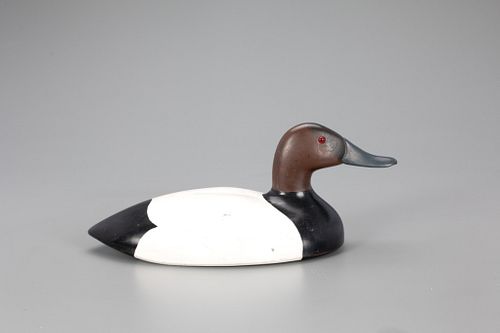The Modern Canvasback Drake Decoy, Joel D. Barber (1876-1952)
About Seller
20 Winter Street
Pembroke, MA 02359
United States
Founded in 2005, Copley Fine Art Auctions is a boutique auction house specializing in antique decoys and American, sporting, and wildlife paintings. Over the course of the last two decades, the firm has set auction records for not only individual decoy makers, but also entire carving regions. Copley...Read more
Two ways to bid:
- Leave a max absentee bid and the platform will bid on your behalf up to your maximum bid during the live auction.
- Bid live during the auction and your bids will be submitted real-time to the auctioneer.
Bid Increments
| Price | Bid Increment |
|---|---|
| $0 | $50 |
| $1,000 | $100 |
| $2,500 | $250 |
| $5,000 | $500 |
| $10,000 | $1,000 |
| $25,000 | $2,500 |
| $50,000 | $5,000 |
About Auction
Feb 19, 2021
Lots 1-292 Copley Fine Art Auctions cinnie@copleyart.com
- Lot Description
Joel D. Barber (1876-1952)
Wilton, CT, c. 1940
16 in. long
The legendary Joel Barber Collection and archives is held in the Shelburne Museum in Vermont. In 2019, Chief Curator, and Barber specialist, Kory Rogers presented, and Copley Fine Art Auctions supported, a special exhibition titled "Joel Barber & The Modern Decoy." In addition to his legendary writing and collecting, Barber dedicated much time and effort to creating the ideal modern decoy. He believed that "no matter how good a whittler you are, you can't forge the duck decoys of the old masters." This decoy and the bluebill in this sale illustrates a part of his ambitious pursuit.
Barber only produced approximately fifty decoys in his lifetime. The underside is branded "BARBER DECOYS" and bears a white-paper label with the inscription "Given to E. L. Voorhees by Joel Barber 1942."
Included with this lot is a 1st edition copy of Barber's 1934 "Wild Fowl Decoys" book. It is from the library of George Thompson who has inscribed the book and included a copy of Barber's "visiting card." Also included is a copy of the 1931 Abercrombie & Fitch exhibition catalog which features a Barber illustration of a canvasback ridging a wave.
Original paint with minimal wear.
Provenance: Joel Barber Collection
E. L. Voorhees Collection, gifted from the above, c. 1942
Private Collection, Massachusetts, acquired from the family of the above
Literature: Kory W. Rogers, "Birds of a Feather," Shelburne, VT, 2017, pp. 12, related decoys illustrated, p. 16 related diagram illustrated. p. 61, related pair illustrated. Ralf Coykendall, "Modern Decoys by Joel Barber," patterns illustrated. Henry C. Chitwood, "Connecticut Decoys," West Chester, PA, 1987, p. 70, related decoy illustrated. Joel Barber, "Wild Fowl Decoys," New York, NY, 1954, p. 149, pl. 117, similar decoy illustrated.Please email condition report requests to colin@copleyart.com. Any condition statement given is a courtesy to customers, Copley will not be held responsible for any errors or omissions. The absence of a condition statement does not imply that the lot is in perfect condition.Condition
- Shipping Info
-
Copley Fine Art Auctions does not handle the shipping of any items. Shipping is the sole responsibility of the buyer. Once your payment has cleared and we have received your shipping form, items may be released for shipment. Copley Fine Art Auctions, LLC shall have no liability for any loss or damage to such items. Buyers should allow up to four weeks for shipment.
Please be aware that internet bidders may NOT not pick up their items at the sale. Items will be available for pick up by appointment or by shippers five days after the sale.
-
- Buyer's Premium



 EUR
EUR CAD
CAD AUD
AUD GBP
GBP MXN
MXN HKD
HKD CNY
CNY MYR
MYR SEK
SEK SGD
SGD CHF
CHF THB
THB














